The spot gold price may have baffled investors since its move south last December, but analysts at Citi now see the precious metal being a leading indicator of U.S. Treasurys.
Gold is about to enter "phase two" of its bear market, according to the investment bank, after a brief rally and its downside target is now $1,111 per ounce from its current price of $1,231. As well as this bearish outlook, it now sees gold being a leading indicator of U.S. Treasury bills.
"Gold prices fell before and after (U.S. Federal Reserve Chairman Ben) Bernanke's warning about tapering in May, they then stopped falling in July, well ahead of the September FOMC (Federal Open Market Committee) 'no taper'. In fact, by the time of the September FOMC decision gold was falling again," analysts at the bank said in a research note released on Monday.
(Read More: Goldman predicts steep losses for gold in 2014)
"Gold seems to anticipate monetary policy developments earlier than USTs. This is possibly because gold has, in the end, no intrinsic worth and no yield and is therefore hyper-sensitive to U.S. and global monetary policy."
Citi's research shows that gold now has a roughly 60-day lead over 10-year Treasury yields. This suggests yields will be 2.9 percent by late January, it said, or 3.25 percent if gold hits $1,111.

Often seen as a hedge against inflation, gold traditionally has had an inverse relationship to interest rates with demand for the precious metal increasing when rates are low.
(Read More: Bargain hunters get ready to buy gold)
Last December was seen as a key turning point for gold prices with the commodity losing its close relationship with Fed policy announcements.
In the 10 years up until last December, gold had surged around 400 percent, with the help of low interest rates, extra Fed liquidity and concerns over the global economy. Then on December 12 , the Fed announced that it would buy $45 billion in additional Treasurys every month, on top of the $40 billion of mortgage-backed securities it already purchases, taking the total size of its quantitative easing program to $85 billion a month.
Instead of this being bullish for gold, the precious metal actually posted a surprise fall of 1 percent. Michael Derks, chief strategist at FxPro who now no longer works for the company, said at the time that the rules surrounding the price of gold had suddenly changed.
(Read more: Gold set for biggest weekly loss in 2 months)
"For the gold bulls to remain in the ascendancy next year, a lot will depend on the much-feared inflation from global quantitative easing starting to show through. It's proving to be a long wait though," he said in a research note at the time. Sure enough, gold has since then fallen 27 percent.
By CNBC.com's Matt Clinch. Follow him on Twitter @mattclinch81
Clarification: This article has been altered to reflect that Michael Derks no longer works for FxPro.


